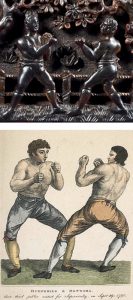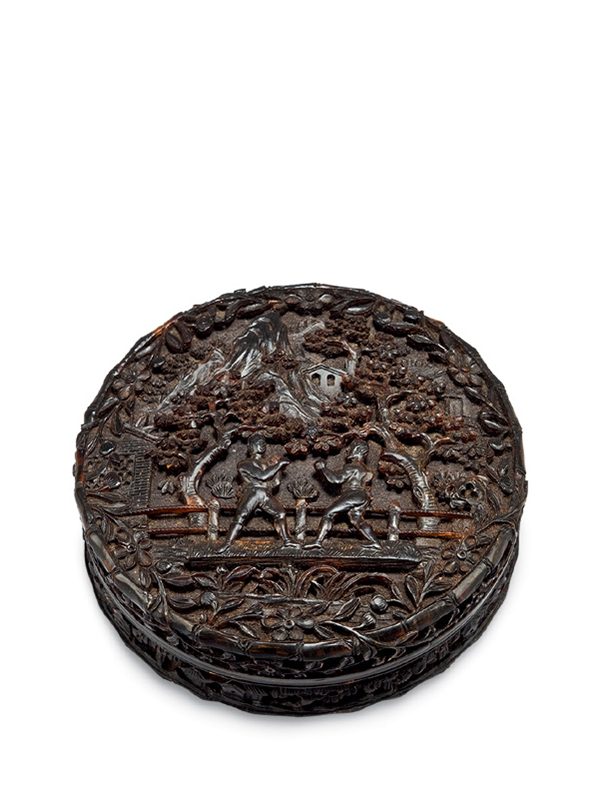029 Tortoiseshell box
A tortoiseshell box of circular form with slightly domed cover and straight sides. The domed cover is carved with an intricate and detailed scene of an open-air boxing match between two Western men. The platform upon which they stand is framed on either side by a pine and prunus tree and set against a Chinese landscape with rugged mountains with small pavilions on the top. The scene is bordered by a bamboo design and a repeat design of flowering branches, which extend up and over the bamboo border from the sides. The sides of the lid are decorated with a design of flowering branches while small pavilions amidst a wooded and mountainous terrain decorate the sides of the container. The base of the box is carved in shallow relief and shows four Chinese figures in a garden setting against landscape, with houses, trees and rocky outcrops.

Fig. 1 Coloured etching, ‘Humphries & Mendoza, their 3rd public contest for Superiority, on September 29, 1790’, dated to 1812. Museum of London
This intricately carved and very unusual tortoiseshell box is a perfect example of the combination of Chinese landscape and a western theme that was popular from the 18th century. Tortoiseshell carvings of objects including small boxes, combs and other personal items originating in China during the late 18th century in Guangzhou.[1] Such boxes were aimed at the western market and were very popular in the Regency period in England in particular.[2] Elaborately carved snuffboxes made from tortoiseshell showing an armorial shield or initials are much more commonly found.[3] The depiction of western figures in a Chinese setting is extremely rare or even unique. Closely comparable depictions of boxing matches are seen in several coloured etchings, dated between the late 18th and early 19th century; some are in the collection of the Museum of London (fig. 1)[4] and some in the Bridgeman Art Library .[5] Looking at the depiction of the two bare-knuckle boxers and their dress style, typical of English boxing, this box could well be made for the English market. An example of the fairly commonly found tortoiseshell box depicting a view of Napoleon’s tomb on St. Helena is in the collection of the Hong Kong Museum of Art and is dated to circa 1830.[6] Another comparable tortoiseshell box made about 1820 is in the Jenyns Collection at Bottisham Hall in Cambridgeshire.[7]
- Clunas, C., Chinese Carving, Victoria and Albert Museum, London, 1996, p. 32
- Waston, W. ed. Chinese Art: Textile, Glass and Painting on Glass, Carvings in Ivory and Rhinoceros Horn, Carvings in Hardstones, Snuff Bottles, Inkcakes and Inkstones, 1981, Oxford, Phaidon, p. 172
- A slightly larger tortoiseshell circular box with a full armorial of Robertson of Strowan in Scotland and surrounded by Chinese scholars was in the exhibition A Tale of Three Cities in 1997. See: Howard, S. David ed. A Tale of Three Cities: Canton, Shanghai & Hong Kong- Three Centuries of Sino-British Trade in the Decorative Arts, 1997, Sotheby’s, no. 256, pp. 194-5
- The Museum of London online collection archive, accession number 74.41/7
- Bridgeman Art Library online collection archive, asset: PER 205344, BSA 273448, BSA 273442, BSA 273456
- Hong Kong Museum of Art online collection archive, no. C1981.0009
- Watson, W. op. cit. no. 133, p. 172
玳瑁雕西洋拳擊人物圖圓盒
清 十八世紀
徑:7.8 公分 高:2.2 公分
玳瑁雕蔗段式盒,子母口,通體勻稱深褐色質地。蓋面中心高浮雕兩位西洋人物,以西洋拳擊預備姿
勢相對,上身赤裸,著十八世紀時的英式標準拳擊褲裝,後有圍欄為界。界後遠景雕高山密樹,屋舍
立於一隅。蓋與盒緣淺浮雕竹節紋一周,蓋面沿邊飾以纏枝花紋一周延伸至蓋側壁,盒側壁則雕以屋
宇山樹紋。盒底淺浮雕中式人物庭園景致。盒內光素無紋,顯露玳瑁天然質地。玳瑁製品為十八世紀
時廣州作坊的產品之一,主要外銷歐洲市場,並接受樣稿訂製服務。類似蓋面的兩位西洋拳擊手形
象,可見於英國十八世紀末至十九世紀初的蝕刻版畫收藏。依據兩位拳擊手精準的英式拳擊褲裝描繪
及罕見的主題選擇,本品應是外銷至英國市場,並由英國訂製方提供蝕刻版畫樣稿,便於廣州工匠依
樣製作。

